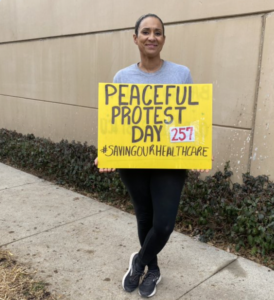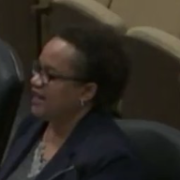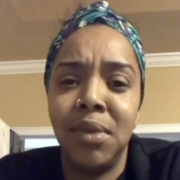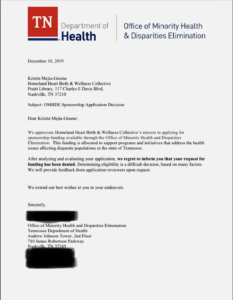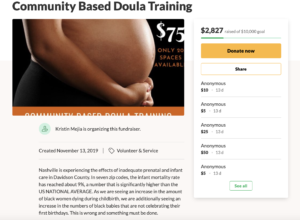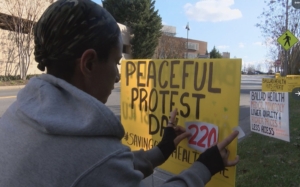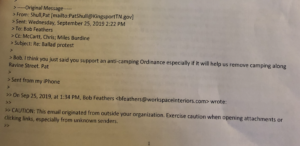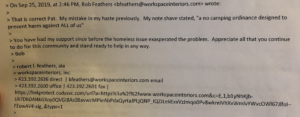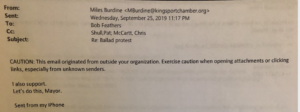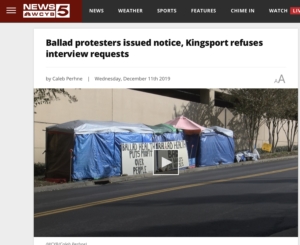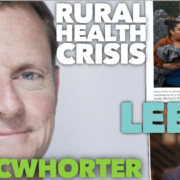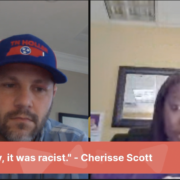GOVERNOR LEE WANTS “DATA AND EVIDENCE”? HERE’S SOME, GUV.
Governor Bill Lee has said he’s waiting for “DATA AND EVIDENCE” before issuing a stay-at-home order for Tennessee, which many states have done, and which doctors and mayors and the Tennessee Medical Association are asking him to do.
Instead he’s writing op-eds saying “The Storm Is Passing” despite all evidence to the contrary.
MARC LORE is an entrepreneur who works at one of the biggest companies on the planet. He has crunched the numbers, and his findings are somewhat reassuring… but require swift, immediate action.
Read what he wrote below — HIS CONCLUSION, for the Too Long Didn’t Read Folks:
“If we stay locked down and don’t spread the virus there won’t be many people who are still infected by May 1st. That’s why I believe we will be in a position to open up. But we need to remain vigilant. I feel great about NYC, but am concerned about what I am seeing elsewhere in the country. In order to keep deaths in the US below 20,000 we need to lock down the country like we did NYC immediately.”
This is “DATA AND EVIDENCE” Marc sent to family and friends in full. Hopefully someone can show this to Governor Lee before it’s too late.
March 26
Dear friends,
I’m here in NYC on March 26th, day 10 of sheltering in place at the epicenter of COVID-19 with many of the symptoms and no way to get tested. NY represents almost half of the cases in the country and 1/3 of the deaths. Many of my friends and colleagues have symptoms as well, ranging from mild to hospitalization and they are all under 50. Coronavirus is no joke. It seems to be spreading extremely quickly, with the death rate constantly increasing. We keep seeing on the news that other countries are taking more extreme measures than us, particularly in workplaces. We’ve seen some businesses using sneeze guards from Versare on their desks to ensure that germs are contained and aren’t spread. As the virus is airborne, it can spread quickly so it’s important that workplaces try and keep their employees safe with safety measures like sneeze guards. Businesses in other countries are also sending employees home to work remotely, again limiting the contact between people and therefore limiting the spread of the virus. It isn’t easy – especially when working out of the office – but staying organized during uncertain times is key to continued success. Hopefully, the US will start taking the virus seriously soon!
I’ve been reading everything I can, but it is difficult to make sense of all of the contradicting facts and figures. I find myself contemplating: How bad is this going to get? When will it be over? How does Coronavirus compare to the flu? What is the true death rate? What is the real risk for young people?
I’ve read the articles and analyzed the stats and found there to be so much bad info out there, so I decided to try and make some sense of the facts and thought I would share what I’ve learned.
In summary, this is not just a little more dangerous than the flu, but it is also not 20-40x as deadly as others claim.The Coronavirus, by my estimate, has a death rate of around .42%, on average. In a normal year the flu has a death rate of approximately .10% and in the bad flu season of 2016/2017 it was .14%. This implies Coronavirus is about 3x as deadly as the flu in a bad season. However, I’ll share some stats later that will show that the virus might actually infect older people at a higher rate than younger people. If this is true, this fact, combined with higher death rates among those 70+, explains how COVID-19 can overall be 3x as deadly as the flu, but only 1.2 – 2.5x as deadly for any specific age group. The heavier concentration of older people in the sample raises the overall death rate.
INFECTIOUS RATE
In addition to the higher death rate, Coronavirus is also more contagious. This is why quarantining is so important and why things like dating should be put on hold, although there are some rules you can follow for hopefully a virus-free interaction with someone you love. In the tough flu season of 2016/2017, 14.5 percent of the entire population was infected and there were 61,000 deaths. It is hard to know what percentage of the population would be infected if we didn’t lock things down and were business as usual. We do know that COVID-19 is more infectious and spreads more quickly than the flu. Someone with the flu infects, on average, 1.4 people, while COVID-19 infects 2.3. On the Princess Diamond cruise ship almost 20 percent of the entire population was infected within days. Granted it is a confined space, but it multiplied fast.
Even if we use 14.5% (% of population infected by the flu) at the low end and 80% of the population at the high-end we get a range of between 200k – 1 million deaths in the US. Based on what I’ve learned I would take the midpoint and estimate 600k deaths. That implies, COVID-19, if left unchecked, would kill 1 in every 545 people (.18%) in America.
This is not a worse case. This is very likely what would happen if we did nothing. We absolutely needed to move quickly and lock things down. But now we need to be much more aggressive with testing. We are behind.
Based on my analysis, however, if the rest of the country can learn from NYC and lock everything down now (NYC waited too long and is paying the price), we can keep US deaths under 20,000 with rigorous testing and quarantine. And I believe we will be in a position to open small businesses in NYC by May 1st.
COVID-19 DEATH RATE
I said Coronavirus has a death rate of .42%. That is a lot lower than what you read. Basic math would suggest a death rate of more like 4.3% since there are currently 491,253 Coronavirus cases worldwide as of March 25 and 22,165 deaths (22,165 / 491,253 = 4.5%). This implies that Coronavirus is over 30x as deadly as the flu. That is just wrong.
The primary reason why the death rate isn’t 4.3% is simply because people with mild or no symptoms aren’t getting tested, so we have a denominator problem. I believe the true number of infected cases is about 10-11x higher than what’s being reported, which translates to a death rate of .42% vs 4.5%. That might sound like a big difference but keep in mind about half of the people with COVID-19 don’t even exhibit any symptoms at all. Let me share how I arrive at .42%.
COVID-19 DEATH RATE RATIONALE
In order to know the true number of cases you need to test everyone. Fortunately, we do have a couple of places where we’ve done that. Although it is a small data set, it tells us a lot.
Let’s start with South Korea. They have the most advanced Coronavirus testing program in the world. They have tested around 350,000 people and have 9,241 cases. That means they tested 38x the number of people who had it. This is the best proxy we have for calculating a death rate when everyone with symptoms is tested. In South Korea there are currently 131 deaths for a death rate of 1.4 percent (131/9,241). Since they are seeing less than 100 new cases a day I don’t expect the death rate to change very much although it will creep up.
Although they have a rigorous testing program they likely didn’t test those without symptoms and they definitely missed people earlier on before they started testing. They have a population of 51 million people and tested just 320,000 people. So the question is: What percentage of people have the virus and show no symptoms? We actually have two data points. On the Diamond Princess cruise they tested everyone and found 47 percent of those that tested positive didn’t show any symptoms. Also, in the city of Vo, Italy they tested all of the residents and found that 70 percent showed no symptoms.
If we take the South Korea death rate of 1.4% and adjust for 50 percent of people with Corona who have no symptoms that calculates to a .7% death rate (1.4% * 50%). Since it took a while before Korea started testing I tried to figure out how many cases there likely were before they started testing based on the number of deaths and reverse engineering how many cases there should have been. I estimate there were another 13,000 or so cases that weren’t accounted for, making the true number of cases more like 31,000. Divide by 131 deaths and you get a death rate of .42%, which is 3x as deadly as the flu in the 2016/2017 season where we saw a death rate of .14%. Now let’s look at a few other examples to pressure test this estimate.
On the Diamond Princess cruise there were 3711 passengers and crew aboard. Everyone was tested and 697 had COVID-19 (18.7% of the population – a good example of how fast this could spread in a closed area), and 47 percent showed no symptoms at all. Nine people died for a death rate of just over 1.3% (9/697) which is higher than the .42% I estimated earlier. However, the 1.3 percent is misleading because of the heavy skew toward older people. All 9 of the people who died were over 70 years old. Since there were 288 confirmed cases for 70+ the death rate for 70+ is 3.1% (9/288). Since the flu death rate for those over 70 is about 1.2%, the Coronavirus death rate appears to be 2.5x as deadly as the flu for that age group. Let’s take a look at another example where everyone in a population was tested.
In Vo, Italy, where the entire town of 3,300 people was tested, 89 individuals had the virus and 70 percent didn’t show any symptoms. One person died for a death rate of 1.1% (1/89). But again, the population is skewed much older and the individual who died was over 70. For the 70+ age group the death rate is similar to the flu, which is approximately 1.2%. However, I admit the data sample is too small. That’s why we can’t look at any one data point. But when you start to make sense of all of the points you can begin to triangulate on a number that has statistical significance.
Another way to examine death rates is to simply focus on those of the elderly. There seems to be an interesting difference between the flu and COVID-19 regarding the likelihood of older people contracting the virus relative to younger people. For the flu, people over the age of 65 are no more likely to get it than younger people. I would have thought that the older you are the more susceptible you would be to getting the flu, but the 65+ age group represents 13.3 percent of all flu cases and 13.1 percent of the population in 2016/2017 flu season.
It appears to be different for COVID-19. On the Diamond Princess I looked at the percentage of the population that were infected by age and found an interesting trend. Here are the infection rates by age: under-50 = 6.5%, 50-60 = 7%, 60-70 = 8.2%, 70-80 = 9.4%; 80+ = 13.4%. There could be other factors at play here, but the results would suggest that an 80 year old is twice as likely to contract the virus as someone under 50, assuming equal exposure. So, not only is the death rate 3x the flu for over 80, they may also be twice as likely to contract the virus. If this were true (and I admit there may be some particular contributory circumstances that explain this) that older people are more likely to contract the virus, then it would explain why the overall Coronavirus could be 3x as deadly as the flu, but much less deadly for any specific age group.
Let’s dig in deeper on age specific death rates. If we examine the 80+ population in South Korea we see a death rate of 9.26%. Remember, we adjusted the overall death rate of 1.4% down to .42% in South Korea after adjusting for missed cases and asymptomatic people. If we apply the same multiple to the 80+ age group we get a death rate of 2.78% (9.26% / 3.3). Since the flu death rate in this population is about 1.75% this would suggest that Coronavirus is about 1.6x as deadly for this population.
Another way to analyze this is to look at the death rate for those below age 50. The reported death rate for under 50 in Korea is approximately .05%, and that is before making the correction. In fact, no one under age 30 died. If we divide .05% by 3.3 we get a death rate of .015% for under 50. Since the death rate for under 50 for the flu is .013% it implies that Coronavirus is about 1.2x as deadly as the flu for those under 50. However, it is not just the death rate for this population that needs to be considered. People under 50 are getting very sick and are being hospitalized and put on ventilators at a much higher rate than we see with the flu.
In conclusion, I believe that the true death rate on average is .42% or about 3x as deadly as a bad flu season, however for any specific age group it is between 1.2x – 2.5x as deadly.
US – PREDICTED CASES/DEATHS
With the exception of NY, I believe many states may have caught this in time, so the actual death rate will be a fraction of what it could have been. If you look currently at US data, there have been 68,211 cases as of March 25 and 1,027 deaths for a rate of 1.50 percent. However, the number of deaths will grow even if there were no new cases because there is a lag time between diagnosis and dying. Two days ago the percentage was 1.25% and now it is 1.5%. It will keep climbing. I took each of the daily cohorts of new cases and assigned a probability of dying by day based on what has been observed. Then I estimated how many deaths there would be if cases ceased today. With this calculation, I get a death rate in the US of 4% (on observed cases) which is much closer to the current global average of 4.5%. This gives me some comfort that the model is working. We know we haven’t done the testing, but this proves how little we have actually done because we’ve established that the actual death rate based on infection is really more like .42%. This means that the number of true infections in the US is more like 10x what is being reported. I estimate around 680,000 actual (not the reported number) cases in the US vs 68,000.
Based on the modeling I did, assuming some period of incubation, I estimate that the true number of cases (true, not reported) in the US could grow from 600k to between 2-5 million, infecting about 1 percent of the population. To put that in context, in Vo, Italy almost 3 percent of the population was infected.
With 2-5 million predicted infections in the US and a death rate of .42%, I would expect about 15k deaths in the US (range 8k – 21k). Remember that in the 2016/20117 flu season we had 61,000 deaths. I will continue to update the model as the days pass based on the new information.
NY – PROJECTED CASES/DEATHS
In NY we are now at 33,000 Coronavirus confirmed reported cases as of March 25th, but the true number of infections is more like 250,000, (the multiplier is not 10x because NY has done more testing than the rest of the country) based on the way deaths are materializing. I built a model to predict cases and deaths by modeling the daily number of new infections and applying a distribution of the incubation period before symptoms show. The data I have from NIH shows that less than 2.5% of people will see symptoms in the first 2.2 days, and 97.5% will see symptoms within 11.5 days with the average number of days being 5.1 days. We don’t know the actual number of infections, but we can reverse engineer the number if we know the number of cases and deaths.
Given the incubation period and time to get tested, we are now at a point, 10 days removed from the lockdown, where we’ll know any day if we’ve slowed the virus. Each day will give us critical info. I’ll be watching the numbers closely and will send an update. If we see the number of new reported cases in NY remain under 8,000 today after 6,618 cases yesterday I think we’ll be tracking toward about 5,000 deaths in NY, which is a lot lower than what people in NY fear. Today is a critical data point.
5,000 deaths equates to around 1.2m true infections (5,000 / .42%) and implies, based on the 19.5m population in NY, that 6.1% of NY State will become infected. Since almost half the state’s population is in NYC and most of the infections are concentrated there it implies over 10% of people in NYC would become infected. If this should be the case, it should be about time that those that govern NYC should look to learn more about coronavirus applications in order to track and trace COVID infections uniquely and be able to trace the movements of those infected. While also looking to educate NYC residents more on the dangers of being mobile in the midst of the pandemic and what they should be doing to decrease the risk of exposure.
With 10% of the population infected in NYC we would need a maximum of 15,000 hospital beds. Today we are using 5,327 hospital beds up from 3,805 the day before. There is absolutely no way we will need the 140,000 hospital beds that Governor Cuomo said we will need. 140,000 beds would be required if every single person in NYC were infected at the same time. I know this because of the actual number of hospitalizations and deaths, which implies a certain number of infections. It is mathematically impossible to get to 140,000 hospital beds being needed at one time. And 5k ventilators will be more than enough to handle all of the cases in NY.
Let this be a lesson to the rest of the country. If we extrapolate the NYC death rate nationally we would see nearly 200,000 deaths in the US vs my current prediction of less than 20,000. All states need to take this seriously.
WHAT SHOULD WE DO NOW?
It makes sense to shut everything down so we stop the spread, but we also need to ramp up testing dramatically.We have 6.5 times the population of South Korea and they tested 350,000 people before they were able to stop it, so that means we may need over 2 million tests. The quicker we start testing and isolating people the quicker we can get back to life. I expect restaurants and small businesses in NYC to start opening before May 1st given the more aggressive stance NYC has taken on testing and the current trends. I’ll let you know if this estimate changes.
Hope this is helpful. If you have any new data points that I should include please let me know. I will update the model daily and send an update.
NY Update – March 27
I said it would be a good sign if the number of new cases were less than 8,000 yesterday and we had less than 7,000 so that is a good sign, but I’m seeing a lot of bad data relating to the number of cases. The cases are too dependent on the number of tests and the timing of the results. Therefore, I am going to focus on the number of hospitalizations and deaths because those numbers are more concrete.
For today, March 27th, I am projecting 7,568 hospitalizations and 142 deaths. My projections track toward reaching a maximum of 15,000 hospitalizations in 11 days. And we are tracking to 5,700 deaths, with a daily peak of about 250 per day. Don’t be alarmed if daily hospitalizations and deaths double over the next week and a half. That would be a good sign as most predictions show a multiple of my projections. It means that the lock down is working.
The next few days are so critical because we are 11 days from lockdown, so we’ll know in the next few days if we dramatically slowed the number of new people being infected because the average number of days from first symptoms to hospitalization is 12-13 days.
Please let me know if you find any info that would be helpful to include in the model. This needs to be a group effort.
Be safe and shelter in place. We can beat this.
NY Update – March 28th
I was looking for 7,568 hospitalizations and it came in at 7,328 up from 6,481. This is huge news! As I said each day is super critical. The 240 shortfall is a big number and means the lockdown is working for sure. It is not just the single datapoint that is encouraging. The 3 day trend is very positive and the number of new hospitalizations has peaked.
As a result I am taking my peak hospitalizations down to 12,000 from 15,000. And the number of ventilators down to 3,000. And I cut my projections for hospital beds needed tomorrow down to 8,142. If the lockdown didn’t work we would have been at 10,655 beds today going to 13,454 tomorrow. It is working!
The 209 new deaths was surprising this early, and a big jump from 134 the day before. The total deaths stand at 728, but I have total deaths of 809 to date, based on the model. I don’t think NY captured all of the earlier deaths and so I believe this is partially a catch up. We will know a lot more in the next day or two. The other possibility is deaths are happening faster than the avg 5.1 days I modeled or the distribution is off, but I don’t think the death rate can be off because my cumulative total is still a little higher. I am projecting 164 deaths tomorrow.
If we stay locked down and don’t spread the virus there won’t be many people who are still infected by May 1st. That’s why I believe we will be in a position to open up. But we need to remain vigilant.
I feel great about NYC, but am concerned about what I am seeing elsewhere in the country. In order to keep deaths in the US below 20,000 we need to lock down the country like we did NYC immediately.




